Stay on the couch or go for a run? There's an app that can calculate the bigger risk
- Written by Hassan Vally, Senior Lecturer in Epidemiology, La Trobe University
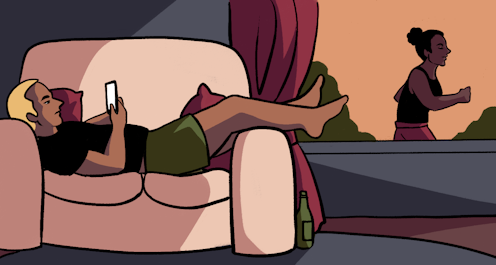 We know running is better for you than lounging but how might it affect our lifespan?Marcella Cheng/The Conversation, CC BY-ND
We know running is better for you than lounging but how might it affect our lifespan?Marcella Cheng/The Conversation, CC BY-NDHumans are much worse at estimating risk than we think we are. While we overestimate the risk of rare but catastrophic occurrences, such as being attacked by a shark, many of us seriously underestimate the risk of behaviours that reduce our lifespan, such as smoking.
These errors of judgement are potentially costly, leading to bad decisions and many premature deaths.
Now there is an app designed to help us avoid rushing toward an early grave. Risk Navigator allows you to select an activity and find out immediately, in clearly understood terms, the risk (or benefit) this has on your health.
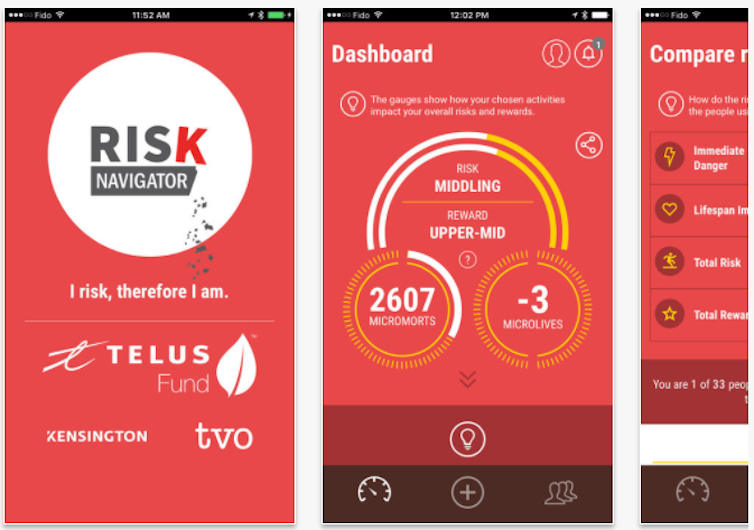 You can look up and compare different types of risks on the Risk Navigator app.Risk Navigator
You can look up and compare different types of risks on the Risk Navigator app.Risk NavigatorRead more: What’s most likely to kill you? Measuring how deadly our daily activities are
To get full value from the app it is important to understand that there are two types of risk: acute and chronic. Acute risks are those that may kill you immediately, such as a car accident.
Chronic risks don’t kill you immediately but rob you of your life a little at a time. If you choose to eat an unhealthy diet, for instance, you may appear to be getting away with this, but you risk developing illnesses in future that may shorten your life.
The problem is we value things a whole lot less when they occur in the future. Distant events are abstract – we don’t know how and when they might affect us – so we care less about them. This is is known as temporal discounting, a concept I explain in a Conversation podcast episode on risk here.
How it works
Acute risks can be measured in a unit called “micromorts”, which represents a one in a million chance of death. It’s a simple way to convert acute risks into units that are easy for us to understand.
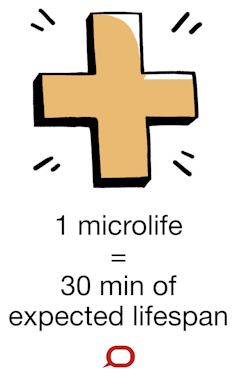 Marcella Cheng/The Conversation, CC BY-ND
Marcella Cheng/The Conversation, CC BY-NDChronic risks can be assessed using “microlives”, a unit of measurement developed by Cambridge University Professor David Spiegelholter. A microlife is the probability of something you do increasing or decreasing your expected adult lifespan by 30 minutes.
For many people, expressing chronic risks into a cost to your lifespan in the here and now makes it much easier to understand these types of risk.
What are the biggest risks?
Looking at the activities in the app, we can see that smoking is just about the worst choice you can make for your health. Every two cigarettes that you smoke takes one microlife (or 30 mins) off your lifespan.
 Every two cigarettes that you smoke takes one microlife (or 30 mins) off your lifespan.Marcella Cheng/The Conversation, CC BY-ND
Every two cigarettes that you smoke takes one microlife (or 30 mins) off your lifespan.Marcella Cheng/The Conversation, CC BY-NDIn contrast, eating vegetables is clearly very good for you, with each serve increasing your lifespan by two hours. This is a massive health gain and clearly should be a strong motivator to eat healthily.
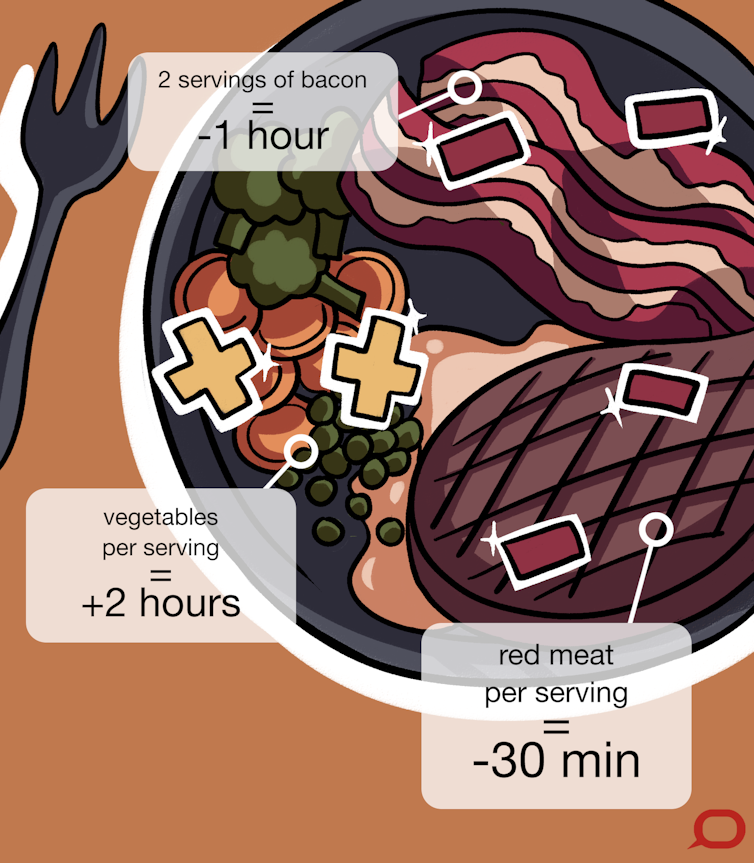 Eating vegetables is clearly very good for you, with each serve increasing your lifespan by two hours.Marcella Cheng/The Conversation, CC BY-ND
Eating vegetables is clearly very good for you, with each serve increasing your lifespan by two hours.Marcella Cheng/The Conversation, CC BY-NDInterestingly, the most current data indicates that drinking coffee is also good for you, though with limited health gains. Each cup of coffee (assuming you drink moderately), is associated with approximately a ten-minute gain in your lifespan.
Read more: What you need to know to understand risk estimates
Even drinking alcohol may add to your lifespan, with each serve adding 30 minutes to the length of your life. But this health gain is only true for the first drink; subsequent drinks shorten lifespan.
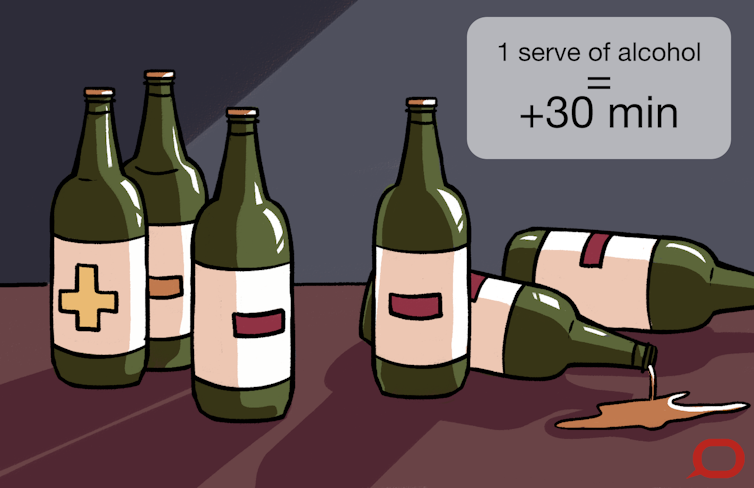 Marcella Cheng/The Conversation, CC BY-ND
Marcella Cheng/The Conversation, CC BY-NDAlcohol also poses an acute risk when consumed in excess. Binge drinking gives you a 25 in one-million chance of sudden death (25 micromorts).
Sitting on the sofa for one hour reduces your lifespan by about 15 minutes. Alternatively, if you decide to exercise, the latest data suggests that the first 20 minutes of exercise increases your lifespan by about one hour. Subsequent exercise is still beneficial but the biggest payoff comes with getting out there and doing that first 20 minutes.
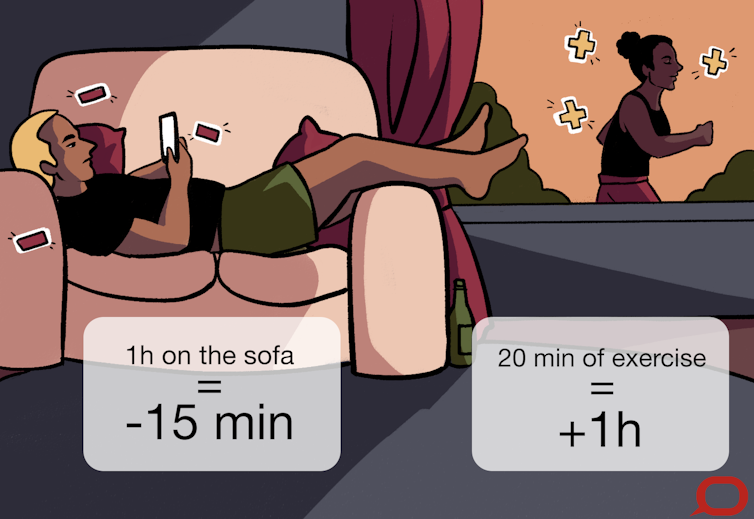 Sitting on the sofa for one hour reduces your lifespan by about 15 minutes.Marcella Cheng/The Conversation, CC BY-ND
Sitting on the sofa for one hour reduces your lifespan by about 15 minutes.Marcella Cheng/The Conversation, CC BY-NDOf course, going for the run may not always be the best choice – it may be raining or you might not be in the mood – but over time you can start to see how entrenched patterns of behaviour can impact the length of your life.
Keep in mind that that while there are some limitations associated with these estimates of risk, which are based on averages across the whole population, they can provide us with a greater perspective on the magnitude of the risk associated with the things we do.
We shouldn’t necessarily be risk averse or neurotic about exposure to risks. Life is all about making decisions about risks and rewards, and we all have a different threshold for what we consider acceptable risks to take. Even if we don’t always make the healthiest decisions, at least we can make ones that are fully informed.
Hassan Vally does not work for, consult, own shares in or receive funding from any company or organisation that would benefit from this article, and has disclosed no relevant affiliations beyond their academic appointment.
Authors: Hassan Vally, Senior Lecturer in Epidemiology, La Trobe University





